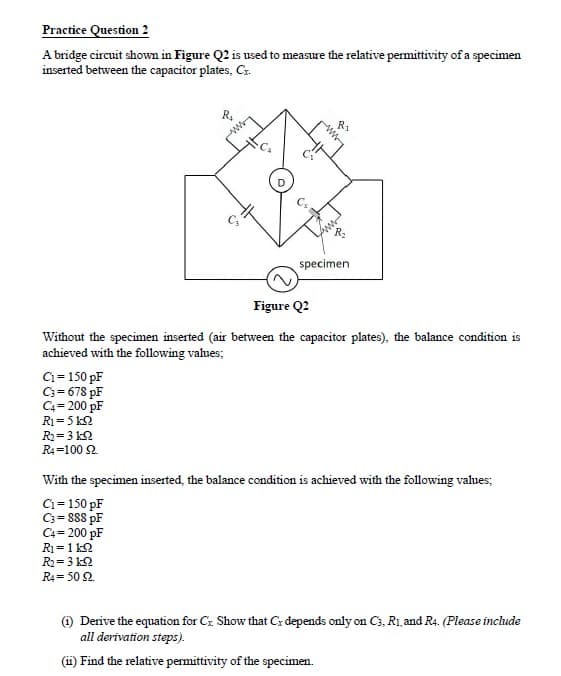Practice Question 2 A bridge circuit shown in Figure Q2 is used to measure the relative permittivity of a specimen inserted between the capacitor plates, Cr. specimen Figure Q? Without the specimen inserted (air between the capacitor plates), the balance condition is achieved with the following values; C= 150 pF C3= 678 pF C4= 200 pF R=5 k2 R=3 k2 R4-100 2 With the specimen inserted, the balance condition is achieved with the following values; 150 pF C= sss pF C4= 200 pF R=1 k2 R= 3 k2 R4= 50 2 () Derive the equation for Cz Show that C: depends only on C3, R1, and R4. (Please inchude all derivation steps). (i) Find the relative permittivity of the specimen.
Practice Question 2 A bridge circuit shown in Figure Q2 is used to measure the relative permittivity of a specimen inserted between the capacitor plates, Cr. specimen Figure Q? Without the specimen inserted (air between the capacitor plates), the balance condition is achieved with the following values; C= 150 pF C3= 678 pF C4= 200 pF R=5 k2 R=3 k2 R4-100 2 With the specimen inserted, the balance condition is achieved with the following values; 150 pF C= sss pF C4= 200 pF R=1 k2 R= 3 k2 R4= 50 2 () Derive the equation for Cz Show that C: depends only on C3, R1, and R4. (Please inchude all derivation steps). (i) Find the relative permittivity of the specimen.
Introductory Circuit Analysis (13th Edition)
13th Edition
ISBN:9780133923605
Author:Robert L. Boylestad
Publisher:Robert L. Boylestad
Chapter1: Introduction
Section: Chapter Questions
Problem 1P: Visit your local library (at school or home) and describe the extent to which it provides literature...
Related questions
Question

Transcribed Image Text:Practice Question 2
A bridge circuit shown in Figure Q2 is used to measure the relative permittivity of a specimen
inserted between the capacitor plates, Cz.
R1
specimen
Figure Q2
Without the specimen inserted (air between the capacitor plates), the balance condition is
achieved with the following values;
Ci= 150 pF
C3 = 678 pF
C4= 200 pF
R1= 5 k2
R= 3 k2
R4=100 2.
With the specimen inserted, the balance condition is achieved with the following values;
C1= 150 pF
C3= 888 pF
C4= 200 pF
R1=1 k2
R2= 3 k2
R4= 50 2.
%3D
) Derive the equation for Cx Show that C: depends only on C3, R1, and R4. (Please include
all derivation steps).
(i) Find the relative permittivity of the specimen.
Expert Solution
This question has been solved!
Explore an expertly crafted, step-by-step solution for a thorough understanding of key concepts.
Step by step
Solved in 3 steps with 4 images

Knowledge Booster
Learn more about
Need a deep-dive on the concept behind this application? Look no further. Learn more about this topic, electrical-engineering and related others by exploring similar questions and additional content below.Recommended textbooks for you

Introductory Circuit Analysis (13th Edition)
Electrical Engineering
ISBN:
9780133923605
Author:
Robert L. Boylestad
Publisher:
PEARSON

Delmar's Standard Textbook Of Electricity
Electrical Engineering
ISBN:
9781337900348
Author:
Stephen L. Herman
Publisher:
Cengage Learning

Programmable Logic Controllers
Electrical Engineering
ISBN:
9780073373843
Author:
Frank D. Petruzella
Publisher:
McGraw-Hill Education

Introductory Circuit Analysis (13th Edition)
Electrical Engineering
ISBN:
9780133923605
Author:
Robert L. Boylestad
Publisher:
PEARSON

Delmar's Standard Textbook Of Electricity
Electrical Engineering
ISBN:
9781337900348
Author:
Stephen L. Herman
Publisher:
Cengage Learning

Programmable Logic Controllers
Electrical Engineering
ISBN:
9780073373843
Author:
Frank D. Petruzella
Publisher:
McGraw-Hill Education

Fundamentals of Electric Circuits
Electrical Engineering
ISBN:
9780078028229
Author:
Charles K Alexander, Matthew Sadiku
Publisher:
McGraw-Hill Education

Electric Circuits. (11th Edition)
Electrical Engineering
ISBN:
9780134746968
Author:
James W. Nilsson, Susan Riedel
Publisher:
PEARSON

Engineering Electromagnetics
Electrical Engineering
ISBN:
9780078028151
Author:
Hayt, William H. (william Hart), Jr, BUCK, John A.
Publisher:
Mcgraw-hill Education,